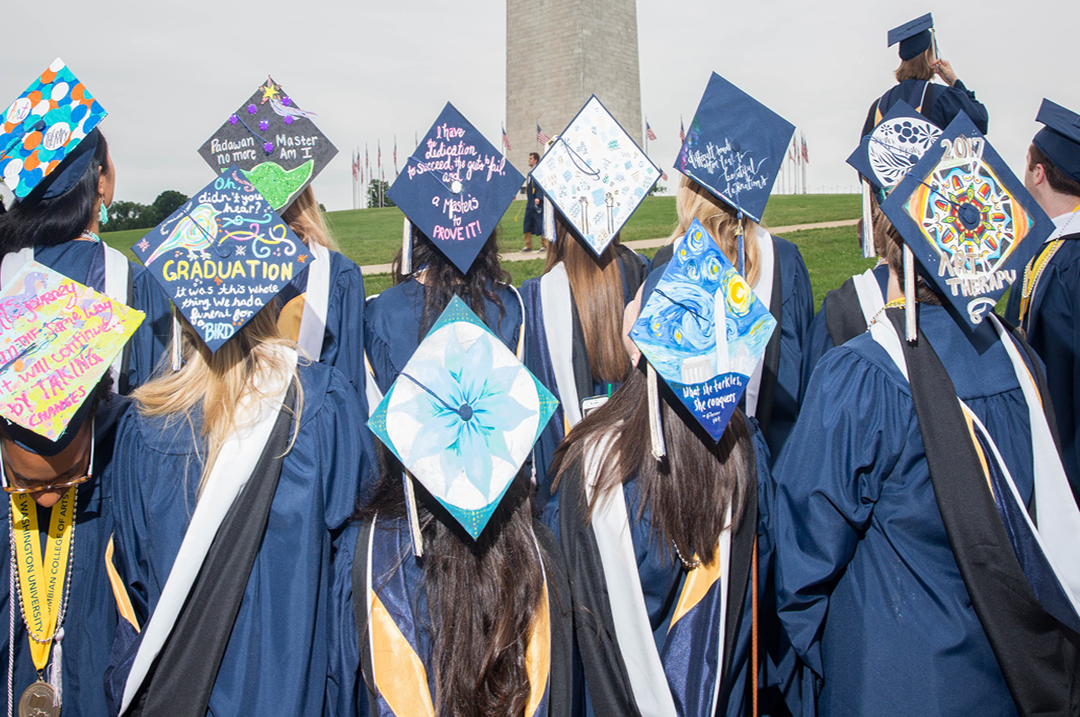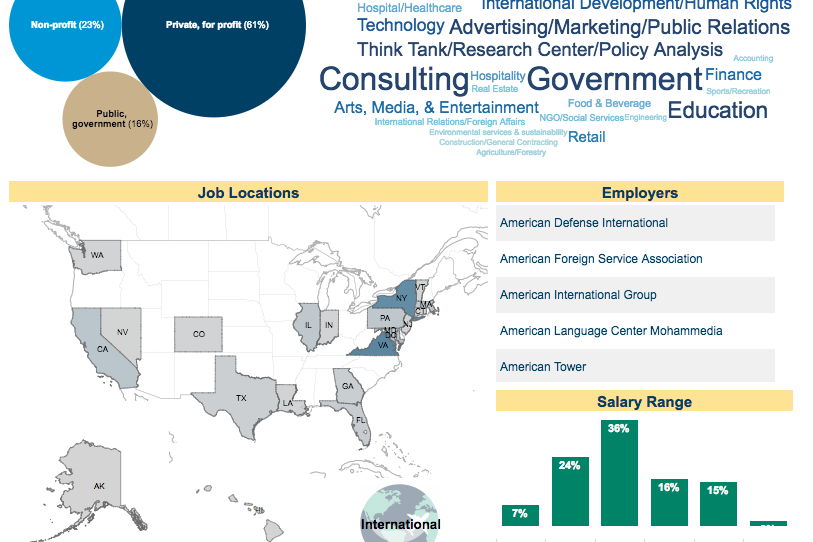By Briahnna Brown
The annual First Destination survey, which reports activities of the university’s most recent alumni six months after their graduation, shows that about nine of 10 graduates in the George Washington University class of 2017 are employed, continuing education or involved in other activities. These results are consistent with the class of 2016’s results.
The Office of Survey Research and Analysis annually conducts a comprehensive survey of every GW senior who applies for graduation. The survey explores questions about their university experience as well as their post-graduation, or first-destination, plans. Data is collected from March to December and compiled and added to the interactive Undergraduate Outcomes Data Visualization, which includes employment and education outcomes for all classes since 2014.
The data helps current and prospective GW students while they consider majors, and they can get a broad look at where a GW degree in various fields of study can take them based on where GW alumni before them have gone.
The class of 2017 has a higher Knowledge Rate—88 percent of graduates—than the previous class. Assistant Provost for University Career Services Rachel Brown explained that it may be because the university continues to tap into new, reliable sources to contribute to results. In 2016, she said, GW began adding information from LinkedIn, and in 2017 the team included data from the National Student Clearinghouse, which keeps a database on schools and degrees of students who attend participating institutions.
Branching out to other data sources allows the results to be more comprehensive than restricting results to just survey respondents, Ms. Brown added, and it follows the guidelines from the National Association of Colleges and Employers (NACE), which allow for a variety of sources to collect first destination outcomes.
“These additional data sources allow for a more accurate picture of student outcomes. We are able to incorporate employment and graduate school information for non-respondents and for those who may have been seeking employment in March but did not update their status as they confirmed their post-graduation plans,” Ms. Brown said.
For the class of 2017, 61 percent of graduates are working part-time or full-time, which includes self-employment or military service. Of those students, 66 percent are working in the private, for profit employment sector, 24 percent in the non-profit sector, and 10 percent in the public or government sector.
Rabani Kapoor, B.A. ’17, said her time at GW earning a degree in international affairs opened up avenues to intern with nonprofits including Polaris, the DC Appleseed Center for Law and Justice and the United Nations. She now works as an associate with Invest India, which is part of the Ministry of Commerce and Industry in India, where she heads the corporate social responsibility program for the organization.
“My career choice is an amalgamation of my professors’ guidance, GW career center advisors, my classes and my internships,” Ms. Kapoor said. “I owe due diligence to all four in helping me shape my career.”
Twenty-three percent of graduates in the class of 2017 are enrolled or planning to enroll in continuing education, with the majority of those students—65 percent—pursuing a master’s degree and 15 percent pursuing a law degree. Five percent of respondents are engaged in some other activity, which includes community service work or travel.
Joseph Sitzmann, B.A. ’17, decided to pursue a law degree at the University of Chicago after studying political science at GW. He said he appreciated his professors’ guidance in applying to law school, as well as the internship opportunities he had being in Washington, D.C., internships with the Federal Judicial Center and the U.S. Supreme Court that he was able to land because of a career advisor at GW. His internships helped him make connections with professionals in the legal field and made him more competitive for the top law schools.
“Having that breadth of experience has helped to put what I am learning in law school into a larger, real-world context,” Mr. Sitzmann said. “I also hope to rely on those networks I established for future employment opportunities.”
Based on user feedback, the data visualization has been updated to make it easier for users to search for and learn about industries and organizations graduates are involved in along with additional information about the majors that GW offers. With such positive feedback on the undergraduate outcomes visualization, GW created a data visualization for graduate student outcomes, and a data visualization on internship information will be available later in the spring.




